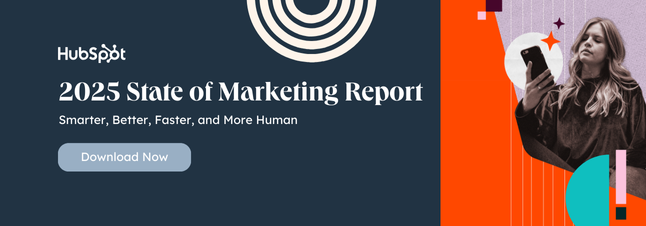Social media, email, video, audio —today's marketers have more marketing channels to choose from than ever before.

As the former head of marketing for two different tech companies, I learned firsthand that an effective marketing strategy must consider all these channels and identify the best investments for your specific company, product, and target market.
Of course, this is easier said than done. The marketing channel landscape is constantly growing and evolving, and it’s essential to understand the value that each channel can provide.
The HubSpot team surveyed over 1,000 global B2B and B2C marketing professionals to explore the most used marketing channels.
Below, I’ll share the top marketing channels identified in that survey. I’ll discuss how I’ve found these channels can help you amplify your reach and drive revenue while prioritizing your current customers.
Marketing Channels to Focus On
- Social Media
- Websites/Blogs
- Email Marketing
- Omnichannel Marketing
- Video Marketing
- Influencer Marketing
- Search Engine Optimization
- Podcast Marketing
- Word-of-Mouth Marketing
Top B2B Marketing Channels
According to HubSpot’s survey, more than 80% of marketers feel that marketing has changed more in the last three years than in the previous fifty.
In this ever-changing environment, the number one challenge marketing professionals identify is determining which platform (or platforms) they should invest in.
When making these critical decisions, I’ve found that it’s helpful to do some benchmarking against other professionals in the industry.
Our survey found that the top marketing channels today’s marketers use are short-form video (i.e., TikTok, Reels, YouTube Shorts, etc.), influencer marketing, and Search Engine Optimization (SEO).
Moreover, the survey found that 41% of B2B marketers are increasing their budgets, enabling them to invest in new marketing channels.
Specifically, in addition to the channels described above, B2B marketers mainly focus on website and blogging channels and email newsletters.
In fact, nearly one in three marketers report leveraging email marketing to engage with potential customers.
These targeted email campaigns can run manually and be automated, empowering marketers to focus their energy elsewhere.
Many marketers are also leveraging new tools that allow them to segment subscribers and personalize their messages, maximizing the impact of these campaigns.
However, our data suggests that short-form videos, influencers, and SEO are the most significant channels to watch.
Top B2C Marketing Channels
Many B2C marketers use platforms similar to their B2B counterparts but with a few key differences. For B2C professionals, social media and email are the top marketing channels, followed by websites and blogs.
In general, B2C marketing is usually focused on offering enjoyable content and quick wins, while B2B marketing focuses on building longer-term relationships with customers. As such, focusing on social media makes sense for B2C.
After all, as of 2023, there are nearly 5 billion social media users worldwide (more than 60% of the global population), making this the ideal platform to cast a wide net and reach a broad consumer audience.
HubSpot’s survey offered further support for the importance of social media, finding that B2C brands were most likely to invest in marketing efforts on Facebook, Instagram, and YouTube.
The data shows that LinkedIn is a more important platform for B2B brands than B2C, with B2B marketers substantially more likely to report investing in this platform.
Alongside social media, the survey identified email as a significant marketing channel for B2C brands. Sometimes, this can refer to a traditional newsletter.
Still, email can also be used to share B2C content such as personalized communications, time-sensitive notifications (like product launches or sales), and cart abandonment email reminders.
Another significant advantage of email is that it’s an owned media channel. Nobody can dictate when, how, or why you can contact your prospects.
At the same time, it’s essential to remember that your customers will unsubscribe if you oversaturate their inbox with too many emails.
Finally, the HubSpot report found that 36% of B2C marketers use blogs and websites to connect with customers, helping these brands generate brand awareness, drive traffic, convert leads, and, most importantly, establish authority.
When you create your blogs and website content with SEO tactics in mind, you’re even more likely to meet your goals.
This is because these strategies can help your content rise to the top of the SERP (Search Engine Results Page) when customers make queries related to your business content.
It’s easy to get complacent when it comes to marketing channels.
However, our survey found that more than half of B2C marketers expect their budgets to grow, suggesting that it’s critical to invest in identifying the best new channels for your brand — and take the time to build out your presence on those channels as effectively as possible.
Omnichannel Marketing
According to HubSpot’s survey of marketing professionals, more than nine out of ten marketers leverage more than one marketing channel — and 81% leverage more than three channels.
In today’s marketing ecosystem, trying to work with just one marketing channel or to implement just one strategy simply doesn’t work. Omnichannel marketing is the only option.
Indeed, according to CMO and co-founder of NP Digital Neil Patel, “100% of the companies we worked with that grew focused on omnichannel marketing and continually expanded.”
This diversified approach helps teams stay agile, adapt to new opportunities, and pivot when specific platforms become oversaturated.
One common approach to omnichannel is content repurposing:
Rather than creating custom content for each platform from scratch, 82% of social media marketers in HubSpot’s survey reported repurposing content across various social channels.
This enables you to ensure brand messaging continuity while reducing the work necessary to engage across many marketing channels.
Video Marketing
Now is the time if you’ve yet to invest in video marketing.
Across industries and markets, I’ve found that video can be a great way to boost conversions, improve ROI, reach new audiences, and help you build relationships with current customers.
That may be why marketers report that video is the top media format they leverage today.
That being said, there are a lot of different kinds of videos. Regarding marketing, short-form content takes the cake for both B2B and B2C marketers.
In the age of TikTok, many social media platforms are rewarding content creators who make short-form video content that encourages viewers to stay on the app longer.
This is also a significant growth area, with 29% of marketing professionals planning to try leveraging video marketing for the first time in 2023. Video can also be a great way to flex your creative skills as a marketer.
For example, I focused mainly on written content early in my career, like blog posts and PR articles.
When my team suggested investing in creating a short promotional video, I was a little nervous at first — but it turned out to be a fascinating project, and the footage drove a lot of sales for our new product.
So, even if you haven’t worked with video before, now might be a great time to start.
Influencer Marketing
Influencer marketing is when businesses partner with a popular creator in their industry to share advertisements or specific pieces of content.
These influencers can generate brand awareness by associating a familiar face and personality with your product in customers’ minds and providing social proof.
This is especially important as research has shown that consumers today trust marketers less and less.
Because of this skepticism, they tend to shy away from traditional lead-generating content, instead turning to influencers for product recommendations.
Because influencers are personable, honest people who share your customers’ interests, buyers are likelier to trust them. In the tech age, influencers might be a modern version of old-fashioned word-of-mouth marketing.
Moreover, the data shows that influencer marketing pays off. A recent report found that 86% of B2B brands are successful with influencer marketing.
In contrast, a study from Shopify found that every dollar spent on influencer marketing had an average ROI of $5.78 — i.e., this strategy can achieve more than 5x returns.
In light of these statistics, it’s no surprise that investment in influencer marketing is on the rise.
HubSpot’s survey found that 17% of marketers planned to try influencer marketing for the first time in 2023, and of those already using this approach, 89% plan to increase or maintain their investment.
Search Engine Optimization
Another critical component of any modern marketer’s strategy is Search Engine Optimization or SEO marketing.
If you successfully optimize your web content, it will position your brand as an authority in your domain, ultimately helping you increase traffic and your conversion rate.
It’s important to note that SEO isn’t just about your website. All of your web content needs to be search engine optimized.
That includes your YouTube channels, Google business profile, and podcast episodes, which should be optimized using target keywords.
The pillar-cluster model is one strategy that can help you organically build a thriving online presence. According to HubSpot data, 35% of B2B and 59% of B2C marketers report this as an effective strategy.
So how does it work? With the pillar-cluster model, you’ll create a single pillar page that provides a high-level overview of a topic and hyperlinks to cluster pages that delve into the topic’s subtopics.
This helps signal to search engines like Google and Bing that your pillar page is an authority on the subject.
Other SEO tactics that can be highly effective include using search insights reports, optimizing photos or videos for visual search engines, and optimizing load speed for any media-heavy web pages.
Remember, this doesn’t have to be a lot of work. In my experience, just spending an hour or two reviewing relevant keywords and noting words and phrases to use in your content can make a big difference in SEO marketing.
Podcast Marketing
In a Pew survey conducted in 2023, 42% of Americans aged 12 and older reported having listened to a podcast in the past month.
Audio content is in high demand, so for many brands, podcasts can be a great platform to reach larger audiences.
Podcast hosts can also serve as brand-specific influencers, demonstrating the human side of your business.
In addition, because people can listen to podcasts passively while doing other things, this can be an excellent channel for reaching people during their morning commutes, walking their dogs, or cleaning the house.
Featured Resource:How To Start a Podcast For Your Business
Podcasts can also be compelling because the human brain is programmed to crave, seek out, and respond to a well-crafted story.
The audio medium can be an excellent opportunity to tell a compelling story, capturing your audience’s attention while making your brand more personable.
Interestingly, just one in three marketers report leveraging podcasts or other audio content in their strategies — but of those that do, more than half say that it is the most influential media format they use.
That may be why podcasts receive the second highest marketing spend, with marketers sharing that video is the only channel they’re investing more in.
Word-of-Mouth Marketing
A 2023 survey from PwC found that more than half of U.S. consumers have recommended a company they trust to their family and friends.
As online content becomes increasingly oversaturated, paid content is trusted less and less, with many buyers instead turning to word-of-mouth recommendations to inform their purchasing decisions.
In this new reality, marketers must earn customers’ trust by relying on customer recommendations and word-of-mouth marketing.
Real customers will be much more effective in earning that trust than marketers, who have agendas and are ultimately focused on their bottom lines.
After all, as marketing professionals, we’re paid to promote our brand’s products — but customers will typically only rave about a product or service if they love it.
So, what does this look like in practice? Word-of-mouth marketing is about more than just face-to-face conversations.
Satisfied customers might post about your brand online, tell their roommates they like your service, or leave positive reviews on your product pages.
Only one of these examples involves an actual, in-person conversation, but they’re all ways consumers can vouch for your brand’s credibility.
At its core, word-of-mouth marketing is all about creating a customer experience that’s just so magical that existing users are driven to share your brand with their networks.
As a customer, I’m only motivated to tell my friends about a product if I’ve had a stellar experience.
If you focus on offering top-notch customer service and on always going above and beyond for your customers, you’ll be set up to succeed with word-of-mouth marketing.
Make Your Marketing Channels Work for You
Now that you know the stats behind different marketing channels, there are two key questions: First, how might you reach your existing audience in a new way? And second, how might a new channel enable you to reach new audiences?
Different marketing channels come with different benefits, but most businesses can find a way to use different channels in their marketing strategies to meet their unique business goals.
Studies have shown that customers are likely to come into contact with your brand at least seven times before taking action.
As such, using a range of different marketing channels can be a great way to create those multiple points of contact, nurture your leads over time, increase conversions, and help you achieve your marketing goals.
Editor's Note: This post was originally published in Dec. 2021 and has been updated for comprehensiveness.
![Download Now: Free State of Marketing Report [Updated for 2024]](https://no-cache.hubspot.com/cta/default/53/b0f73a5e-16e4-41fd-9511-8564efc560a7.png)

![6 Steps to Create an Outstanding Marketing Plan [Free Templates]](https://www.hubspot.com/hubfs/marketingplan_20.webp)







